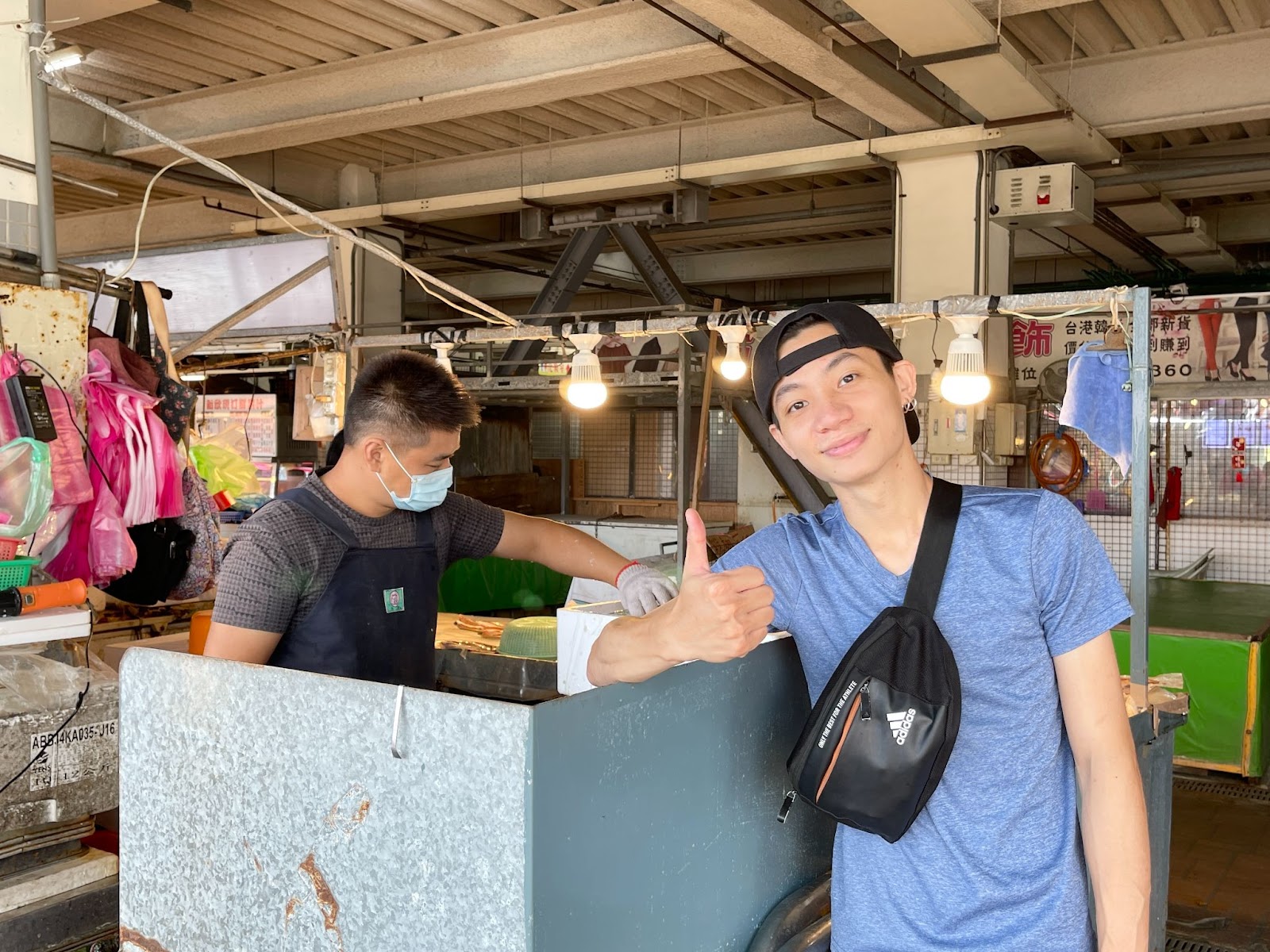Hualien【Sea×Food】Report
2022.03.31
Taiwan(台湾)
Guest speaker: Hao, Kuo
Coordinator: Jing Liao
Date: 10/24
海 × 食マンジャックベリーのピクルスを添えた台湾風蒸し魚 by シェフ ハオ
Introduction
Hello, I am Jing from Taiwan, coordinator of the UMITOMACHI project in Taiwan. In the Sea x Food section, I would like to invite my friend, Hao, as a guest speaker to show you how to cook Taiwanese steamed fish with pickled manjack berries.
こんにちは。私は、UMITOMACHIプロジェクトの台湾コーディネーター、ジンです。今回海と食のテーマでは、私の友人、シェのハオさんをゲストとして招き、マンジャックベリーのピクルスを添えた台湾風蒸し魚の作り方を紹介します。
Hao, born in Hualien, has a great interest in cooking. He has worked as a chef for more than six years. The restaurant he used to work at is highly rated as one of the best grilled steak and seafood restaurants in Hualien. He can cook Taiwanese/Chinese & Western food and is interested in Japanese food as well.
ハオは花蓮生まれで、料理に大きな関心を持っています。彼は6年間シェフとして働き、花蓮で最高のグリルステーキとシーフードレストランの1つとして高く評価されているレストランで働いていました。彼は台湾/中華/西洋料理に精通していて、日本食にも興味があります。
In this video, in the first part, he will take us to a traditional market in Hualien to select fresh fish and a special ingredient called pickled manjack berries, commonly used for steamed fish dishes. And in the second part, he will take us to the kitchen and show us how to cook the fish!
映像の前半部分では、ハオが花蓮の伝統的な市場へ連れて行ってくれて、新鮮な魚と台湾でよく蒸し魚料理に使用されるピクルスマンジャックベリーと呼ばれる特別な食材を選びます。 そして後半では、キッチンへ移動し、魚の調理方法を教えてくれます!
At the Traditional Market
Around 10 am, we went to a traditional market called 重慶市場 Chong Qi Market. On that day, due to the bad weather condition, there weren’t many fish to select from. We ended up selecting a fish called 馬頭 (Matou in Chinese, Horse head fish in English, アマダイ in Japanese). The meat of the horse head fish has a tender texture, which fits steamed cooking the best.
10時頃、伝統的な市場、重慶市場に行きました。その日は天候が良くなかったので、多くの魚が多くありませんでした。その中で馬頭 (アマダイ)を選びました。アマダイの身は柔らかいテクスチャで蒸し料理に一番合うのです。
We bought 300g of horse head fish for only 120 NT dollars (around 500 yen).
300gのアマダイを120ニュー台湾ドル(約500円)で買いました。
We found the owner of the fish stand where we bought the fish already drunk in the daytime. Hao joked about that in the sharing, saying that the more drunk they are, the more energy they have!
私達が魚を購入した魚屋さんのオーナーは、昼間にも関わらずお酒を飲んでいました。
ハオが、「お酒を飲む、元気になります!」とジョークを言っておりました。
Important to know: to cook steamed fish, make sure the fish is as fresh as possible. That’s why we went to the market to choose. It’s better not to use the frozen one; straight out of a fisherman’s boat is the best. The freshness of the fish contributes the most to the success of this steamed dish.
知っておくべき重要なこと:蒸し魚を調理するには、魚ができるだけ新鮮であることを確認してください。 そのため私たちは市場に行って選びました。 冷凍のものは使用しない方が良いです。 漁師さんが釣ったばかりのものが一番。この蒸し料理の成功に必要なのは、魚の鮮度です。
Cooking Time
[Ingredient]
horesehead fish
Tofu
Chinese mung bean noodles
fish sauce
pickled manjack berries 0.5 spoon
rice wine 1 spoon
mirin 1 spoon
tofu sauce
oyster sauce 1 spoon
soybean sauce 1 spoon
sesami oil
salt
spring onion
sliced dried chilli
[材料]アマダイ
豆腐
春雨(春雨)
フィッシュソース
マンジャックベリーのピクルス 0.5スプーン
米酢 1スプーン
みりん 1スプーン
豆腐ソース
オイスターソース スプーン 1杯
醤油スプーン 1杯
ごま油
塩
ネギ
スライスした乾燥唐辛子
[cooking steps]Have fish gutted and descaled.
Clean the fish with water and lay it on a chopping board.
Cut it at a 45-degree angle several times. This helps it to cook through quickly and allow more flavor to penetrate.
Put the noodles and tofu on the plate evenly, then put the fish on top of the tofu. This helps steam come out easily.
Mix fish sauce and pour it on the fish.
Mix tofu sauce and pour it on the tofu.
Put the fish into a steamer over boiling water for 8 minutes (make sure to time it). If the fish
fin stands, it means it’s almost well-cooked.
(we added one more minute to make the noodles more juicy)
Put green onions and chili on top of the fish.
Heat up the sesame oil for a while. As soon as the oil starts to smoke, pour it over the fish.
【調理手順】
魚の内臓をとり、鱗を取ります。
魚を水できれいにし、まな板の上に置きます。
45度で表面に切れ目を入れます。*すばやく調理し、より多くの風味を浸透させるため。
お皿に春雨と豆腐を平らに並べ、豆腐の上に魚を置きます。これにより、蒸気が出やすくなります。
フィッシュソースを混ぜて、魚の上にかけます。
豆腐ソースを混ぜて、豆腐にかけます。
魚を沸騰したお湯の上で8分間蒸し器に入れます(必ず時間を計ってください)。 鰭が立ったら、それはほとんどよく調理されたのを意味します。
(春雨をもっとジューシーにするために、もう1分蒸しました)
魚の上にネギとチリを載せます。
ごま油を温めて、煙が立ち始めたら魚の上にかけます。
In terms of Taiwanese cooking methods, steaming is very commonly used, especially for fish. Why is steaming important in Taiwanese cuisine? It’s because we believe that steaming is the best way to show the freshness of food and its original taste. Also, the cooking steps are all very easy and there is no need for much seasoning as well. The easier, simpler, the better. Compared to Japan, raw food shows the freshness and original taste, but in Taiwan, though we still eat Sashimi, we prefer cooked fish better.
台湾料理の調理方法では、特に魚の場合、蒸し料理が非常に一般的です。 台湾料理で蒸し料理が一般的な理由? 蒸し料理が、食べ物の鮮度と本来の味を表現する最良の方法であると思われてます。 調理手順は非常に簡単で、多くの調味料も必要としません。 簡単でシンプルであるほど、優れています。 日本では生で食べるのは鮮度と本来の味わいとされますが、台湾では刺身を食べるよりも、蒸し料理などの調理された食べ方を好みます。
Eating time
- Profile
- Taiwan(台湾)
廖品淨 / Jing Liao
ニンジン株式会社 代表 慶応義塾大学大学院でアートツーリズムの地域活性化について研究をし、2017年デザイナーズレジデンシープログラム、DOOR to ASIA東北に参画。会社ではアートPR、台日コラボレーション活動、日本人向け台湾ブランドのセレクトショップなどで活躍している。

REPORT
関連するレポート
-
NEW

Hualien【Sea×Atr&Design】Report
レポート:台湾
Guest speaker: Tammy Tsai coordinator/presenter: Jing Liao Date: 12/19 UMITOMACHI -海とアート&デザイン 馬祖ビエンナーレ Thi […]
-
NEW

Hualien【UMITOMACHI Fes】Report
レポート:台湾
海はいつも私に刺激を与えてくれます。 このプロジェクトを通して、クリエイティブが海からインスピレーションを得ること、そして海が私たちの生活をどのように変えるかを知ることができました。みんなで海の環境を一緒に守る必要があり […]
-

Hualien【Sea×Music】Report
レポート:台湾
Guest speaker: KJ Tien coordinator/presenter: Jing Liao Date: 01/23 UMITOMACHI- 海 x 音楽 | サーフシンガー & […]
-

Hualien【Sea×Marine Sports】Report
レポート:台湾
UMITOMACHI – Sea x Sport | Water activities learning from Hualien Marine Conservation and Jiqi aba […]

